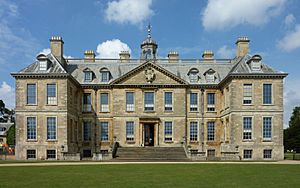Restoration style facts for kids
The Restoration style, also known as Carolean style, describes the art and design that became popular in England from 1660 to the late 1680s. This period began when King Charles II returned to the throne after a time when England was ruled without a king. The name "Carolean" comes from "Carolus," which is Latin for Charles.
When King Charles II and his court came back from living in other European countries, they brought new ideas. The serious and plain style from the time before the king returned (called the Cromwellian style) was replaced. People now wanted things that looked grand and rich. Dutch and French art styles became very popular in England.
Contents
Furniture and Design Changes
You can see these new influences in furniture from the Restoration period. Furniture often featured beautiful floral patterns made from different colored wood, called marquetry. Instead of oak wood, walnut became very popular. Chairs and tables often had twisted legs and supports. People also used fancy, thin layers of wood called veneers from exotic places.
Chairs often had seats and backs made of cane, which is a woven material. Rich fabrics like tapestry and velvet were used for upholstery (the soft padding on furniture). Cabinets often sat on bases that were carved and gilded (covered in gold leaf), with fancy scrolling designs.
Silverware and New Furniture
Restoration silver was special because it had designs of tulips, fruit, and leaves that looked very real. These designs were often "embossed," meaning they were raised from the surface.
Many new types of furniture were introduced during this time. These included cabinets on stands (cabinets placed on tall bases), chests of drawers for storing clothes, comfortable armchairs, and wing chairs (chairs with sides that stick out like wings). Day beds, which were like long couches for resting during the day, also became popular.
Exotic Imports and Chinoiserie
The English East India Company was a powerful trading company. It brought many exciting new goods from places like China, Japan, and India to England. These imports included tea, delicate porcelain (like fancy dishes), shiny lacquerware, and colorful chintz fabrics.
These imports led to a huge interest in "chinoiserie." This was a style that copied Chinese and East Asian designs. People started making imitation lacquer, called Japanning. Blue and white patterns became popular on ceramics. Silver items were decorated with flat, chased scenes showing Chinese-style figures and landscapes. New silver items like teapots also appeared. People also used colorful Indian-style crewelwork (a type of embroidery) for bed-hangings and curtains.
Other Important Developments
The Restoration period also saw the start of the English glass industry. A man named George Ravenscroft invented a new type of glass called lead glass around 1676. This made glass clearer and stronger. Another important development was the making of slipware pottery by Thomas Toft. Slipware uses liquid clay (slip) to create decorative patterns.
After King William III and Queen Mary II came to the throne in 1689, the Restoration style slowly changed. It was replaced by what is now known as the William and Mary style.
See also
Images for kids



